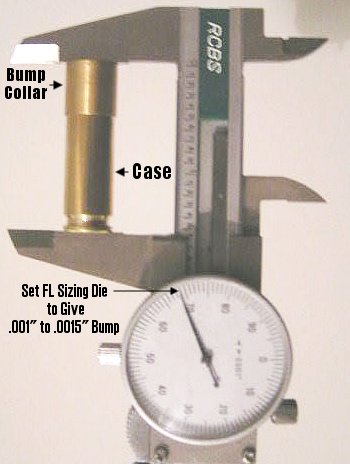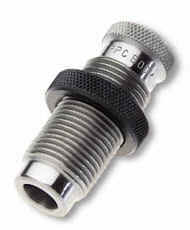September 21st, 2010
Here’s a word to the wise — not all full-length sizing dies are properly dimensioned to carry out the important task of “bumping” shoulders back on fired cases. With some dies the task may simply be impossible (without die or shell-holder modification). In fact, you may find that your attempt to bump the shoulder may actually INCREASE the dimension from base of case to shoulder datum!
 We recently had some four-times fired 6mmBR Lapua brass. Using a Harrell’s collar that indexes off the shoulder, we measured the length from base of case to top of collar at 1.570″ (with primer removed). We noticed a little more resistance to bolt closure compared to fresh brass, so we decided to bump the shoulders back two thousandths. As a point of reference, we measured the same dimension (base of case to top of Harrell’s collar, primer out) as 1.5675″ on once-fired Lapua 6mmBR brass.
We recently had some four-times fired 6mmBR Lapua brass. Using a Harrell’s collar that indexes off the shoulder, we measured the length from base of case to top of collar at 1.570″ (with primer removed). We noticed a little more resistance to bolt closure compared to fresh brass, so we decided to bump the shoulders back two thousandths. As a point of reference, we measured the same dimension (base of case to top of Harrell’s collar, primer out) as 1.5675″ on once-fired Lapua 6mmBR brass.
 This Can’t Be Right …
This Can’t Be Right …
To bump our shoulders we had an RCBS Gold Medal bushing full-length sizing die. Per the manufacturer’s instructions, we started with the die backed off 1/2 turn from contact with the shell-holder with the press ram at full height. We lubed and sized one case and then measured it. The shoulder had not moved. OK, no problem, we screwed the die down to contact the shell-holder (at full ram height) and tried again. This time the measured dimension was actually longer by a couple thousandths. The brass which measured (with collar) 01.570″ before sizing now measured 01.572″ — we were going in the wrong direction!
“Bumped” Shoulder Stretched .003″
Frustrated, we screwed the RCBS die in 1/8th turn past touching to allow “cam-over” which is necessary with some presses to actually push the shoulder back. We sized the case again, and this time the dimension had grown another .001″, to a total length of 1.573″! Wondering if there was something wrong with our calipers, we took the full-length sized brass (which previously had chambered just fine) to our 6BR rifle and tried to chamber it. Sure enough, the headspace had been lengthened by .003″ and the brass would not chamber at all.
 Die Was Too Long Inside to Bump Shoulders Properly
Die Was Too Long Inside to Bump Shoulders Properly
What was going on? Here’s the explanation: the interior cavity of the die was too long so the shoulder surface inside the die was never actually making contact with the shoulder of the brass — and the die could not be screwed down any further. As the RCBS die, which was fairly tight in the bottom half, reduced the diameter of the brass, the case actually grew in length. While the brass was sized at the bottom it grew upwards because the “shoulder” section on the inside of the die was too high. As we “squeezed” the brass at the bottom it simply flowed upwards, increasing headspace.
With this RCBS die, in its current configuration, there was no way we could bump the shoulder back, even by .001″. The die would likely function effectively if we ground a few thousandths off the bottom, but we don’t think a die user should be obliged to make such a modification.
Lesson Learned: If your full-length die can’t bump your brass even when it is screwed down all the way (to cam-over if necessary), then you need a different die or you need to modify your die. As proof of this, we took out my trusty Redding 6mmBR full-length sizing die. This was set up (from experience), one-half turn off contact with the shell-holder. In that position, the Redding die easily bumped the shoulder of a fired case .002″ with no trouble whatsoever. We started at 1.570″ and ended up 1.568″ — right where we wanted to be. The task that couldn’t be done with the RCBS Gold Medal FL Die was accomplished easily with the Redding die. After lubing the case, we simply raised the ram to full height, and this moved the shoulder back .002″ as measured with the Harrell’s collar positioned on the shoulder.
Share the post "Bedeviled by Bump — When Full-Length Dies Don’t Work"
 Harrell’s Precision sells “semi-custom” full-length bushing dies for the PPC and 6BR chamberings. While the Harrell brothers do not cut the die to spec, they carry a large selection of dies made with slightly different internal dimensions. When you send in your fired brass, the Harrells choose a die from inventory with just the right amount of sizing (diameter reduction) at the top and bottom of the case. Given the quality, and precise fit, Harrell’s full-length dies are a good value at $75.00 plus shipping.
Harrell’s Precision sells “semi-custom” full-length bushing dies for the PPC and 6BR chamberings. While the Harrell brothers do not cut the die to spec, they carry a large selection of dies made with slightly different internal dimensions. When you send in your fired brass, the Harrells choose a die from inventory with just the right amount of sizing (diameter reduction) at the top and bottom of the case. Given the quality, and precise fit, Harrell’s full-length dies are a good value at $75.00 plus shipping. Bump Measuring Collar
Bump Measuring Collar












 To quantify what Preacher says, for starters, we suggest setting your body die, or full-length sizing die, to have .0015″ of “bump”. NOTE: This assumes that your die is a good match to your chamber. If your sizing or body die is too big at the base you could push the shoulder back .003″ and still have “sticky case” syndrome. Also, the .0015″ spec is for bolt guns. For AR15s you need to bump the shoulder of your cases .003″ – .005″, for enhanced reliability. For those who have never worked with a body die, bump die, or Full-length sizing die, to increase bump, you loosen lock-ring and screw the die in further (move die down relative to shell-holder). A small amount (just a few degrees) of die rotation can make a difference. To reduce bump you screw the die out (move die up). Re-set lock-ring to match changes in die up/down position.
To quantify what Preacher says, for starters, we suggest setting your body die, or full-length sizing die, to have .0015″ of “bump”. NOTE: This assumes that your die is a good match to your chamber. If your sizing or body die is too big at the base you could push the shoulder back .003″ and still have “sticky case” syndrome. Also, the .0015″ spec is for bolt guns. For AR15s you need to bump the shoulder of your cases .003″ – .005″, for enhanced reliability. For those who have never worked with a body die, bump die, or Full-length sizing die, to increase bump, you loosen lock-ring and screw the die in further (move die down relative to shell-holder). A small amount (just a few degrees) of die rotation can make a difference. To reduce bump you screw the die out (move die up). Re-set lock-ring to match changes in die up/down position. We recently had some four-times fired 6mmBR Lapua brass. Using a Harrell’s collar that indexes off the shoulder, we measured the length from base of case to top of collar at 1.570″ (with primer removed). We noticed a little more resistance to bolt closure compared to fresh brass, so we decided to bump the shoulders back two thousandths. As a point of reference, we measured the same dimension (base of case to top of Harrell’s collar, primer out) as 1.5675″ on once-fired Lapua 6mmBR brass.
We recently had some four-times fired 6mmBR Lapua brass. Using a Harrell’s collar that indexes off the shoulder, we measured the length from base of case to top of collar at 1.570″ (with primer removed). We noticed a little more resistance to bolt closure compared to fresh brass, so we decided to bump the shoulders back two thousandths. As a point of reference, we measured the same dimension (base of case to top of Harrell’s collar, primer out) as 1.5675″ on once-fired Lapua 6mmBR brass. This Can’t Be Right …
This Can’t Be Right … Die Was Too Long Inside to Bump Shoulders Properly
Die Was Too Long Inside to Bump Shoulders Properly




